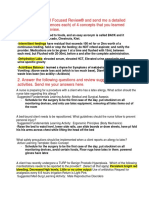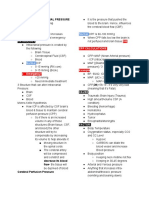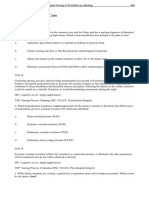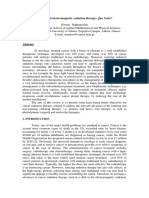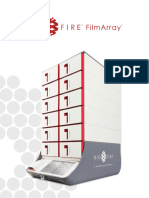Neuro Study Guide
Neuro Study Guide
Uploaded by
Ellen HenningsCopyright:
Available Formats
Neuro Study Guide
Neuro Study Guide
Uploaded by
Ellen HenningsOriginal Description:
Copyright
Available Formats
Share this document
Did you find this document useful?
Is this content inappropriate?
Copyright:
Available Formats
Neuro Study Guide
Neuro Study Guide
Uploaded by
Ellen HenningsCopyright:
Available Formats
NEURO TEST QUESTIONS
1. Know parts to a neuron and each function.
Neurons are the primary functional unit of the nervous system, Although neurons come in
many shapes and sizes, they share three characteristics: excitability, or the ability to
generate a nerve impulse; conductivity, or the ability to transmit an impulse; and
influence, or the ability to influence other neurons, muscle cells, or glandular cells by
transmitting nerve impulses to them.
A typical neuron consists of a cell body, multiple dendrites, and an axon . The cell body
containing the nucleus and cytoplasm is the metabolic center of the neuron. Dendrites
are short processes extending from the cell body that receive impulses from the axons of
other neurons and conduct impulses toward the cell body. The axon projects varying
distances from the cell body, ranging from several micrometers to more than a meter. The
axon carries nerve impulses to other neurons or to end organs. The end organs are smooth
and striated muscles and glands.
Many axons in the CNS and PNS are covered by a myelin sheath, a white, lipid substance
that acts as an insulator for the conduction of impulses. Axons may be myelinated or
unmyelinated. Generally, the smaller fibers are unmyelinated.
Neurons have long been thought to be non-mitotic. That is, after being damaged neurons
NEURO TEST QUESTIONS
could not be replaced. The discovery of neuronal stem cells now demonstrates that
neurogenesis occurs in adult brains after cerebral injury. 1
Glial Cells.
Glial cells (glia or neuroglia) provide support, nourishment, and protection to neurons.
Glial cells constitute almost half of the brain and spinal cord mass and are 5 to 10 times
more numerous than neurons.
Glial cells are divided into microglia and macroglia. Microglia, specialized macrophages
capable of phagocytosis, protect the neurons. These cells are mobile within the brain and
multiply when the brain is damaged.
Different types of macroglial cells include the astrocytes (most abundant),
oligodendrocytes, and ependymal cells. 2 Astrocytes are found primarily in gray matter and
provide structural support to neurons. Their delicate processes form the blood-brain
barrier with the endothelium of the blood vessels. They also play a role in synaptic
transmission (conduction of impulses between neurons). When the brain is injured,
astrocytes act as phagocytes for neuronal debris. They help restore the neurochemical
milieu and provide support for repair. Proliferation of astrocytes contributes to the
formation of scar tissue (gliosis) in the CNS.
Oligodendrocytes are specialized cells that produce the myelin sheath of nerve fibers in
the CNS and are primarily found in the white matter of the CNS. (Schwann cells myelinate
the nerve fibers in the periphery.) Ependymal cells line the brain ventricles and aid in the
secretion of cerebrospinal fluid (CSF).
Neuroglia are mitotic and can replicate. In general, when neurons are destroyed, the tissue
is replaced by the proliferation of neuroglial cells. Most primary CNS tumors involve glial
cells. Primary malignancies involving neurons are rare.
strates that neurogenesis occurs in adult brains after cerebral injury. 1
NEURO TEST QUESTIONS
2. Know GLASCOW SCALE score and what the ranges are what they mean.
3. Know each one of the GCS number and what each mean eg. 5 local reactions to pain
4. ANS Sympathetic Nervous System Flight
5.
6. PNS/CNS parts
a. Central Nervous System The components of the CNS include the cerebrum
(cerebral hemispheres), brainstem, cerebellum, and spinal cord
NEURO TEST QUESTIONS
b. Peripheral Nervous System The PNS includes all the neuronal structures that
lie outside the CNS. It consists of the spinal and cranial nerves, their associated
ganglia (groupings of cell bodies), and portions of the ANS.
7. How to check for patients orientation situation is particularly important
8. When checked for eye opening check with least painful stimuli first
9. CRANIAL NERVES
10.Lumbar puncturePOSITION IMPORTANT BACK HUNCHED OVER, L2-5 so they can
aspirate inside vertebrae
a. POST OP-> VS, BED REST, SITE LEAKAGE, ICP
*The client is having a lumbar puncture performed. The nurse would plan to place the
client in which position for the procedure?
1. Side-lying, with legs pulled up and head bent down onto the chest
2. Side-lying, with a pillow under the hip
3. Prone, in a slight Trendelenburgs position
4. Prone, with a pillow under the abdomen.
NEURO TEST QUESTIONS
*The nurse is caring for the client with increased intracranial pressure. The nurse
would note which of the following trends in vital signs if the ICP is rising?
A. Increasing temperature, increasing pulse, increasing respirations, decreasing
blood pressure.
B. Increasing temperature, decreasing pulse, decreasing respirations, increasing
blood pressure.
C. Decreasing temperature, decreasing pulse, increasing respirations, decreasing
blood pressure.
D. Decreasing temperature, increasing pulse, decreasing respirations, increasing
blood pressure.
* A client admitted to the hospital with a subarachnoid hemorrhage has complaints of
severe headache, nuchal rigidity, and projectile vomiting. The nurse knows lumbar
puncture (LP) would be contraindicated in this client in which of the following
circumstances?
1 Vomiting continues
2 Intracranial pressure (ICP) is increased
3 The client needs mechanical ventilation
4 Blood is anticipated in the cerebralspinal fluid (CSF)
*
A client with subdural hematoma was given mannitol to decrease intracranial
pressure (ICP). Which of the following results would best show the mannitol was
effective?
A. Urine output increases
B.. Pupils are 8 mm and nonreactive
C. Systolic blood pressure remains at 150 mm Hg
D. BUN and creatinine levels return to normal
A lumbar puncture is performed on a child suspected of having bacterial
meningitis. CSF is obtained for analysis. A nurse reviews the results of the CSF
analysis and determines that which of the following results would verify the
diagnosis?
1 1. Cloudy CSF, decreased protein, and decreased glucose
2 2. Cloudy CSF, elevated protein, and decreased glucose
3 3. Clear CSF, elevated protein, and decreased glucose
4. Clear CSF, decreased pressure, and elevated protein
A nurse is reviewing the record of a child with increased ICP and notes that the
child has exhibited signs of decerebrate posturing. On assessment of the child,
the nurse would expect to note which of the following if this type of posturing
was present?
a.
b.
c.
d.
Abnormal flexion of the upper extremities and extension of the lower extremities
Rigid extension and pronation of the arms and legs
Rigid pronation of all extremities
Flaccid paralysis of all extremities
*An 18-year-old client is admitted with a closed head injury sustained in a MVA.
His intracranial pressure (ICP) shows an upward trend. Which intervention
should the nurse perform first?
A. Reposition the client to avoid neck flexion
B. Administer 1 g Mannitol IV as ordered
NEURO TEST QUESTIONS
C. Increase the ventilators respiratory rate to 20 breaths/minute
D. Administer 100mg of pentobarbital IV as ordered.
A client with head trauma develops a urine output of 300 ml/hr, dry skin, and
dry mucous membranes. Which of the following nursing interventions is the
most appropriate to perform initially?
A. Evaluate urine specific gravity
B. Anticipate treatment for renal failure
C. Provide emollients to the skin to prevent breakdown
D. Slow down the IV fluids and notify the physician
A 23-year-old client has been hit on the head with a baseball bat. The nurse
notes clear fluid draining from his ears and nose. Which of the following nursing
interventions should be done first?
A.
B.
C.
D.
Position the client flat in bed
Check the fluid for dextrose with a dipstick
Suction the nose to maintain airway patency
Insert nasal and ear packing with sterile gauze
When discharging a client from the ER after a head trauma, the nurse teaches the
guardian to observe for a lucid interval. Which of the following statements best
described a lucid interval?
A. An interval when the clients speech is garbled
B. An interval when the client is alert but cant recall recent events
C. An interval when the client is oriented but then becomes somnolent
D. An interval when the client has a warning symptom, such as an odor or visual
disturbance.
* A 30-year-old was admitted to the progressive care unit with a C5 fracture from a
motorcycle accident. Which of the following assessments would take priority?
A. Bladder distension
B. Neurological deficit
C. Pulse ox readings
D. The clients feelings about the injury
* A client arrives at the ER after slipping on a patch of ice and hitting her head. A CT
scan of the head shows a collection of blood between the skull and dura mater. Which
type of head injury does this finding suggest?
A. Subdural hematoma
B. Subarachnoid hemorrhage
C. Epidural hematoma
D. Contusion
An epidural hematoma occurs when blood collects between the skull and the dura
mater. In a subdural hematoma, venous blood collects between the dura mater and the
arachnoid mater. In a subarachnoid hemorrhage, blood collects between the pia mater
and arachnoid membrane. A contusion is a bruise on the brains surface.
The nurse is caring for the client in the ER following a head injury. The client
momentarily lost consciousness at the time of the injury and then regained it.
The client now has lost consciousness again. The nurse takes quick action,
knowing this is compatible with:
4 A. Skull fracture
5 B. Concussion
6 C. Subdural hematoma
NEURO TEST QUESTIONS
D Epidural hematoma
* Which of the following describes decerebrate posturing?
a. Internal rotation and adduction of arms with flexion of elbows, wrists, and fingers
b. Back hunched over, rigid flexion of all four extremities with supination of arms
and plantar flexion of the feet
c. Supination of arms, dorsiflexion of feet
d. Back arched; rigid extension of all four extremities.
* In planning the care for a client who has had a posterior fossa (infratentorial)
craniotomy, which of the following is contraindicates when positioning the client?
a. Keeping the client flat on one side or the other
b. Elevating the head of the bed to 30 degrees
c. Log rolling or turning as a unit when turning
d. Keeping the head in neutral position
* A client who is regaining consciousness after a craniotomy becomes restless and
attempts to pull out her IV line. Which nursing intervention protects the client without
increasing her ICP?
a. Place her in a jacket restraint
b. Wrap her hands in soft mitten restraints
c. Tuck her arms and hands under the draw sheet
d .Apply a wrist restraint to each arm
A client has signs of increased ICP. Which of the following is an early indicator of
deterioration in the clients condition?
a. Widening pulse pressure
b. Decrease in the pulse rate
c. Dilated, fixed pupil
d. Decrease in LOC
B. CONTRAST- selfish allergy, renal insufficiency, look at BUN/CREATINE LEVEL to see if
there is a type of renal issue, make sure they are well hydrated so contrast medium
can be excreted from the body.
C. AFTER any neuro surgery, pt cannot strain for any BM because it cause cause an
increase ICP so stool softener is used.
D. Know major complications is INFECTION Catheter insertion
E. tion client, maintaining the head in midline. Keep HOB elevated 30 degrees, higher
elevation may lower ICP but decrease systemic blood pressure.
F. Sodium levels
G. CRANIAL FRACTURE POSSIBLE? Dont want to insert an NG tube
H. TBI INTERVENTION ABC MANAGEMENT
I. BRAIN TUMORS- any part of the brain or spinal cord ( primary) Metastasis- (secondary)
most common type new onset of migrainesred flag.
J. Check O2 sat for trauma
K. Hob 30 degrees
L. Hypernatremia fluid and electrolyte balance for ICP/ cerebral edema.
NEURO TEST QUESTIONS
M.
N. CSF Should be:
i. Clear, colorless
ii. Specific gravity= 1.007
iii. pH= 7.35
iv. Pressure less than 60-150 mm H2O
v. Protein 5-45 mg/dL
vi. Glucose 40-70 mg/dL
vii. WBCs= 0-5 cells/mcL
viii. No bacteria or RBCs
notify HCP of CSF leakage at puncture site.
Intracranial pressure (ICP) is the hydrostatic force measured in the brain CSF
compartment. Under normal conditions in which intracranial volume remains relatively
constant, the balance among the three components (brain tissue, blood, CSF) maintains
the ICP. Factors that influence ICP under normal circumstances are changes in (1) arterial
pressure; (2) venous pressure; (3) intraabdominal and intrathoracic pressure; (4) posture;
(5) temperature; and (6) blood gases, particularly carbon dioxide levels. The degree to
which these factors increase or decrease the ICP depends on the brain's ability to adapt to
changes.
NEURO TEST QUESTIONS
OPEN TB-I TYPE OF FRACTURES
SUBDURAL HEMATOMA SUBACUTE
2/15/16
Know about neuron and structure
Do neuro check upon admit or sudden change of mental status.
o How do you check your mental status?
ORIENTATION: Person, place, time, and situation.
** Make sure you do ALL parts of the assessment because you want to get a
proper baseline.
15 highest and best score for gloscow coma scale.
Make sure if your patient is in a coma, put a T after the score.
know the difference between corticated and decorate postureing
know about lumbar puncturing, postion, care before and after procedure.
ABC important, how to control pain, know about CSF Clear colorless, pH, normal pressure*
(60-150)
ICP
Know s/s of ICP decrease LOC, headache, projectile vomiting, tachycardia,
increases systolic, tachythen brady down, slow and regular respirations, visual
and sensory and motor function
Transducer and common complications? INFECTION
INFANT: bulging fontanels, lethargy, increased head circumference
Sunset eyes
How to tx ICP
Interventions to avoid
Flexion of hips, extension of neck, coughing, avoid cluster nursing activities space
out
Know respiratory functioning after, especially every type of procedure
Know the difference between different types of fractures****
Know about post concussion syndrome and focal injury lacerations which is actual tearing
of brain tissue, contusion is bruising of the brain in a local area.
any hemorrhage can be life threatening
NEURO CHECKS AND ALWAYS ABCS
Know what to do before and after any surgical procedure
Dressing check what would you do? Dont change it, measure drainage, make
marks, notice a lot of drainage? Notify physician and the surgeon.
Know difference between primarywithin brain/spinal cord and secondary
metastisis from elsewhere, most common.
NEURO TEST QUESTIONS
2/15/16
Meningitis
o Bacterial-- medical emergency
Fever, headache, Petechiae blood culture and CT scan
o Viral
SYMPTOMS OF A THROMBOTIX STROKE EVOLVE FROM A PERIOD OF SEVERAL HOURS TO DAYS.
LEFT BRAIN STROKE = MEMORY PROBLEMS RELATED TO LANGUAGE AND MAKING DECISION
RIGHT BRAIN STROKE TEND TO BE IMPULSIVE
DONT KNOW THEIR LIMITATIONS
GET CT UPON ADMIT
ABC are important for an ischemic stroke, high bp, monitor for seizure, ICP,
seizure- turn them on their side just in case they start vomiting and PROTECT THEIR HEAD
o
Why is oral care so important? Because it can lead to pneumonia
ACUTE CAREPOSTION THEM ON WEAK AND AFFECTED SIDE FOR 30 MINUTES ONLY
Key distinction between delirium and dementia ---Sudden cognitive impairment and
cogitation delirium rather than dementia
KNOW DIFFERENT BETWEEN SPINAL AND NEUROGENIC SHOCKNEURO CHARACTERIZED
BY HYPOTENSION AND BRADYCARDIA.
CORD INJURY MONITOR RESPIRATORY FUNCTION
CERVICLE INJURY ABOVE C4-> MECHANICAL VENTILATION IS MOST LIKELY REQUIRED FOR
THESE PATIENTS AND MAKE SURE THAT YOU MAINTAIN THE AIRWAY
o Dental hygiene is important for children with cerebral palsy
o PT/OT is one of the most important care for this type of patient, encourage
family to be involved in the patients care.
Care management jaw control
NEURO TEST QUESTIONS
FOLIC ACID 0.4 MG/DAY IF HX OF DEFECTS 4MG/DAY
Major complication of shunts is infection
You might also like
- Chapter 37: Vascular Disorders Harding: Lewis's Medical-Surgical Nursing, 11th EditionDocument12 pagesChapter 37: Vascular Disorders Harding: Lewis's Medical-Surgical Nursing, 11th EditionKrishna RamaNo ratings yet
- Pharmacy Consumer ResearchDocument13 pagesPharmacy Consumer ResearchAhmed Abu AlasrarNo ratings yet
- Goldbergers Clinical Electrocardiography A Simp... (Z-Library)Document385 pagesGoldbergers Clinical Electrocardiography A Simp... (Z-Library)Irakli Ghlonti100% (2)
- Med Surg NursingDocument9 pagesMed Surg NursingNaomi Myrick100% (1)
- Fundamentals Exam ADocument38 pagesFundamentals Exam APatrice Miller100% (3)
- Module 1 Case StudyDocument5 pagesModule 1 Case Studyapi-564432337100% (1)
- Carla Hernandez Clinical WorksheetDocument2 pagesCarla Hernandez Clinical WorksheetJasmyn Rose100% (1)
- Medical-Surgical Nursing Assessment and Management of Clinical Problems 9e Chapter 67Document11 pagesMedical-Surgical Nursing Assessment and Management of Clinical Problems 9e Chapter 67sarasjunkNo ratings yet
- Elsevier Introduction To Maternity and Pediatric Nursing NCLEX Review Answers Chapter 004Document2 pagesElsevier Introduction To Maternity and Pediatric Nursing NCLEX Review Answers Chapter 004SamNo ratings yet
- Chapter 25 26 27 28 29 30Document9 pagesChapter 25 26 27 28 29 30Laneshia Mason86% (7)
- Place in OrderDocument2 pagesPlace in Orderyacieliz100% (1)
- Special - NCLEX - Exam - Jakarta - Students - PDF Filename UTF-8''Special NCLEX Exam - Jakarta StudentsDocument23 pagesSpecial - NCLEX - Exam - Jakarta - Students - PDF Filename UTF-8''Special NCLEX Exam - Jakarta Studentsrizqi100% (1)
- Vati FundsDocument2 pagesVati FundsAudrey Watson100% (1)
- Chapter 16: Fluid, Electrolyte, and Acid-Base Imbalances Harding: Lewis's Medical-Surgical Nursing, 11th EditionDocument13 pagesChapter 16: Fluid, Electrolyte, and Acid-Base Imbalances Harding: Lewis's Medical-Surgical Nursing, 11th EditionKrishna Rama100% (1)
- Test 1Document33 pagesTest 1julialeo67% (3)
- Chapter 21 Intrapartum Nursing AssessmentDocument27 pagesChapter 21 Intrapartum Nursing AssessmentNurse Utopia100% (1)
- Medical Surgical Nursing 7th Edition Ignatavicius Test BankDocument9 pagesMedical Surgical Nursing 7th Edition Ignatavicius Test Bankqocax0% (1)
- Master Plan of Kyoto CityDocument38 pagesMaster Plan of Kyoto CityChris GladisNo ratings yet
- Neurological Dysfunction Exercises-HIZONDocument16 pagesNeurological Dysfunction Exercises-HIZONDan HizonNo ratings yet
- ExamDocument33 pagesExamRhiza Pagdanganan100% (1)
- Hema Q&aDocument126 pagesHema Q&aHoney Lyn AlebioNo ratings yet
- Chapter 11: Parenteral Administration: Intradermal, Subcutaneous, and Intramuscular Routes Test BankDocument7 pagesChapter 11: Parenteral Administration: Intradermal, Subcutaneous, and Intramuscular Routes Test BankLuna TunaNo ratings yet
- Cardiac Practice TestDocument7 pagesCardiac Practice TestroseNo ratings yet
- NCLEX StrokeSeizureDocument9 pagesNCLEX StrokeSeizureArthur Christopher CorpuzNo ratings yet
- Chapter 30Document26 pagesChapter 30Nurse UtopiaNo ratings yet
- Maternal and Child Health Nursing ReviewerDocument16 pagesMaternal and Child Health Nursing Reviewerjoyce.feir03No ratings yet
- Simulated Exam RationalesDocument20 pagesSimulated Exam Rationalesrhymes2u100% (3)
- MedSurg Bullet InfoDocument143 pagesMedSurg Bullet InfoJenniDamu100% (1)
- Ati Endocrine 2016 1Document6 pagesAti Endocrine 2016 1Jamil AhmedNo ratings yet
- ATI Notes PsychDocument6 pagesATI Notes PsychwaliworldNo ratings yet
- Nclex Exam Maternal and Child Health Nursing 2 30 Items PDF FreeDocument8 pagesNclex Exam Maternal and Child Health Nursing 2 30 Items PDF FreeLianne BuensucesoNo ratings yet
- Coronary Artery Disease & Hypertension NclexDocument15 pagesCoronary Artery Disease & Hypertension NclexPotchiee Pfizer0% (1)
- Acute Renal Failure Questions With RationaleDocument2 pagesAcute Renal Failure Questions With RationaleAngelica Mae Adlawan Desalesa0% (2)
- Pharm (Nursing) Dosage Practice Problems - Reconstitution With Answers 1Document5 pagesPharm (Nursing) Dosage Practice Problems - Reconstitution With Answers 1Linsey Bowen73% (11)
- MedSurg NeuroDocument8 pagesMedSurg NeuroZachary T Hall100% (1)
- 50 Shades of Practice QuestionsDocument11 pages50 Shades of Practice QuestionsAmie Ray100% (1)
- Neurologic NCLEX Practice Test Part 1Document10 pagesNeurologic NCLEX Practice Test Part 1mpasague100% (2)
- CH 14 Antepartum Nursing Assessment NotesDocument8 pagesCH 14 Antepartum Nursing Assessment NotesMary LowryNo ratings yet
- Chapter 30 - Management of Patients With Complications From Heart DiseaseDocument7 pagesChapter 30 - Management of Patients With Complications From Heart DiseaseMichael BoadoNo ratings yet
- Maternity and Newborn Nursing ReviewerDocument40 pagesMaternity and Newborn Nursing Reviewerrahkel08No ratings yet
- Nervous System AlterationsDocument45 pagesNervous System AlterationsMajesty ParkerNo ratings yet
- Neurologic DysfunctionDocument75 pagesNeurologic DysfunctionNur SanaaniNo ratings yet
- Quiz EndocrineDocument16 pagesQuiz EndocrineMon DoceNo ratings yet
- Chapter 33 Lewis Q&ADocument6 pagesChapter 33 Lewis Q&Ajaikovsky100% (2)
- 5 TH Key PointDocument12 pages5 TH Key PointDr-Sanjay SinghaniaNo ratings yet
- Top 400 Q & A Ms & FundaDocument9 pagesTop 400 Q & A Ms & FundaericNo ratings yet
- CH 29 - Management of Patients With Structural, Infectious, and Inflmmatory Cardiac DisordersDocument15 pagesCH 29 - Management of Patients With Structural, Infectious, and Inflmmatory Cardiac DisordersPye Antwan Delva100% (1)
- Nclex ExamDocument8 pagesNclex Examchuin8may50% (2)
- Learner'S Worksheet: Clinical RotationDocument3 pagesLearner'S Worksheet: Clinical RotationLecery Sophia WongNo ratings yet
- TestBank Lewis Medical Surgical Nursing 11th 2020.pdf-845-864Document20 pagesTestBank Lewis Medical Surgical Nursing 11th 2020.pdf-845-864هدوء النسمةNo ratings yet
- 81 HematologyDocument18 pages81 HematologyLuis Perez100% (5)
- NCLEX QuestionsDocument5 pagesNCLEX Questionsijeoma00100% (2)
- Peds Final Exam Study GuideDocument47 pagesPeds Final Exam Study GuideSammy Levuong100% (3)
- UWorld Critical CareDocument14 pagesUWorld Critical CareJohnasse Sebastian NavalNo ratings yet
- Pediatric NursingDocument9 pagesPediatric NursingCreighton A. BayonganNo ratings yet
- NLE and NCLEX QuestionDocument28 pagesNLE and NCLEX Questionhelenlorenzana042086No ratings yet
- COMPREHENSIVE NURSING ACHIEVEMENT TEST (RN): Passbooks Study GuideFrom EverandCOMPREHENSIVE NURSING ACHIEVEMENT TEST (RN): Passbooks Study GuideNo ratings yet
- Chicago Review Press NCLEX-PN Practice Test and ReviewFrom EverandChicago Review Press NCLEX-PN Practice Test and ReviewRating: 4 out of 5 stars4/5 (4)
- Endocrine Study GuideDocument5 pagesEndocrine Study GuideEllen HenningsNo ratings yet
- Arf NotesDocument28 pagesArf NotesEllen Hennings100% (1)
- Aspiration PneumoniaDocument3 pagesAspiration PneumoniaEllen Hennings100% (1)
- Pharmacokinetic Study Guide LehneDocument14 pagesPharmacokinetic Study Guide LehneEllen HenningsNo ratings yet
- Date: - Room #Document2 pagesDate: - Room #Ellen HenningsNo ratings yet
- 2012 Utrogestan Natural Micronized Progesterone - From Luteal Phase Defect To Preterm BirthDocument48 pages2012 Utrogestan Natural Micronized Progesterone - From Luteal Phase Defect To Preterm BirthRachel Paredes100% (1)
- World Expert Explains Link Between EMF and Human Disease, Radiation in Ireland 1,000 Times Higher Than RecommendationDocument12 pagesWorld Expert Explains Link Between EMF and Human Disease, Radiation in Ireland 1,000 Times Higher Than RecommendationGon YoNo ratings yet
- 98 PDFDocument4 pages98 PDFKamalNo ratings yet
- MATERI Terallin ConcentrateDocument15 pagesMATERI Terallin ConcentrateNunik AsmiNo ratings yet
- Shock: Docente: Dra. Luísa QuaresmaDocument29 pagesShock: Docente: Dra. Luísa QuaresmaElena AmaralNo ratings yet
- Zracenje 1Document22 pagesZracenje 1DejanNo ratings yet
- Affective Disorders in The Elderly The Risk of Sleep DisordersDocument6 pagesAffective Disorders in The Elderly The Risk of Sleep Disordersyunike M KesNo ratings yet
- 7th Grade - Respirationand Moving-Chapter 1Document56 pages7th Grade - Respirationand Moving-Chapter 1Sri Ghanta NishikaNo ratings yet
- Kenya ARV Guidelines 2018Document230 pagesKenya ARV Guidelines 2018Felix Wafula MusibiNo ratings yet
- 10 Approved Herbal Plants by DOHDocument7 pages10 Approved Herbal Plants by DOHmyca08No ratings yet
- Horner SYndromeDocument3 pagesHorner SYndromeHendri Wijaya WangNo ratings yet
- 3ro Medio - March 2023 - 1st and 2nd WeekDocument9 pages3ro Medio - March 2023 - 1st and 2nd WeekEvelyn RomeroNo ratings yet
- Endocrine Emergencies: Glucose Metabolism DisordersDocument23 pagesEndocrine Emergencies: Glucose Metabolism DisordersJoaquim RodriguezNo ratings yet
- VILLEZAR & CORTEZ RRL - A Right To Die Ethical Dilemmas of Euthanasia PDFDocument13 pagesVILLEZAR & CORTEZ RRL - A Right To Die Ethical Dilemmas of Euthanasia PDFOmar sarmientoNo ratings yet
- Lupin DiagnoticsDocument16 pagesLupin Diagnoticsdrsujeetkumar5869No ratings yet
- BIO270 Tuto 5Document3 pagesBIO270 Tuto 5Mirza KarmilaNo ratings yet
- Daftar Pustaka PGK Dengan DM Tipe 2Document39 pagesDaftar Pustaka PGK Dengan DM Tipe 2David FernandoNo ratings yet
- Types of Fitness ActivitiesDocument7 pagesTypes of Fitness ActivitiesMark Joshua MandaniNo ratings yet
- Aseptic LectureDocument133 pagesAseptic LectureNurul Afifah Azzahrah100% (1)
- Maternal and Child Health NursingDocument17 pagesMaternal and Child Health NursingSarah Jane MaganteNo ratings yet
- Haemostasis: Case StudyDocument19 pagesHaemostasis: Case StudyTusabe FredNo ratings yet
- FilmArray Sales Brochure RevisedDocument26 pagesFilmArray Sales Brochure RevisedSachinNo ratings yet
- ParesthesiaDocument6 pagesParesthesiavishnu sharmaNo ratings yet
- Uptodte TSVDocument215 pagesUptodte TSVcrilala23No ratings yet
- Open Prostatectomy For Huge Prostates Our Experience in A Developing Country 2329 9088.1000132Document3 pagesOpen Prostatectomy For Huge Prostates Our Experience in A Developing Country 2329 9088.1000132Ahmed Ben BellaNo ratings yet
- Bio QP PB2 Xii 2022-23Document7 pagesBio QP PB2 Xii 2022-23Poonam TripathiNo ratings yet
- TrombidiumDocument6 pagesTrombidiumDohn JoeNo ratings yet














